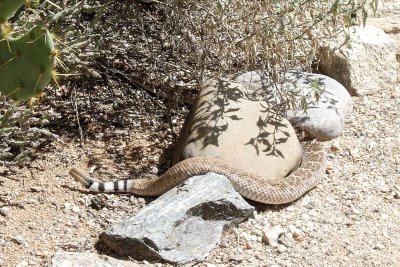I was looking up in the trees for hummingbirds as we walked along the trail. My spouse was about five feet ahead. He suddenly veered away from the trail's edge. A beautiful Diamondback was curled up in the sun. He stared at us; we stared back. He turned away; we continued walking. It was then that my wits returned and I remembered the little emergency camera in my shoulder bag (yep - this was a walk day, not a photography day). I pulled it out of its case and turned back, but by then the snake had lost all interest in us and was beating a retreat.
 The Western Diamondback (Crotalus atrox) is the second largest snake in the United States, second only to the Eastern Diamondback. It inhabits dry, rocky, shrub-covered terrain where it can conceal itself inside crevices in the rocks or in mouse holes. These rattlesnakes are generally heavy-bodied, with a slender neck and broad triangular head. Only rattlesnakes have rattles, which are a series of loosely interlocking horny segments at the end of the tail. Each link of the rattle is the remnant of a molted skin; as the snake molts, the last scale loosens but does not fall off. As the snake ages, new rattles are formed with each molt, while old rattles simultaneously fall off. Thus the number of rattles does not indicate the age of the snake.
The Western Diamondback (Crotalus atrox) is the second largest snake in the United States, second only to the Eastern Diamondback. It inhabits dry, rocky, shrub-covered terrain where it can conceal itself inside crevices in the rocks or in mouse holes. These rattlesnakes are generally heavy-bodied, with a slender neck and broad triangular head. Only rattlesnakes have rattles, which are a series of loosely interlocking horny segments at the end of the tail. Each link of the rattle is the remnant of a molted skin; as the snake molts, the last scale loosens but does not fall off. As the snake ages, new rattles are formed with each molt, while old rattles simultaneously fall off. Thus the number of rattles does not indicate the age of the snake. From the University of Michigan Animal Diversity Web site:
From the University of Michigan Animal Diversity Web site:Western Diamondback Rattlesnakes are aggressive and easily excitable. This species causes more fatalities than any other snake in the United States. They are not necessarily apt to attack offensively, but are rather highly defensive. Their rattles are used as a warning sign.(Thanks to Girl Gone Gardening for her comment on rattlesnake aggression. I've edited my post accordingly.)

7 comments:
Wow!! Thanks for the photo of retreating snake - it's made my night's viewing! :)
Met a couple of these fellows in the upper Yosemite a few years ago. Miles and miles away from any road. Was very happy to move to higher ground out of their territory.
The pictures are clear and have a kind of beauty but I still shudder every time I see any signs of these creatures.
Yay! for the emergency camera and your quick response. We don't see snakes like that up here. What a great, scary creature. We humans are not often confronted with something that could result in a deadly encounter. A rather awesome moment.
I have seem more bull snakes than rattlers. Although in northeastern Utah, I met a desert rattler. They are small, but highly poisonous.
Good pics. :-)
RD and chiefbiscuit - This rattler was relatively small - smaller than the ones I've seen at the Desert Museum. In retrospect, I'm surprised that I felt no fear - just respect and curiosity. (When I was eight years old, I was alone in the woods surrounding our house in Maryland when a copperhead came across my path. I was terrified. I froze and it crawled right over my foot.)
endment - When we walked in Sabino Canyon today, I kept my eyes on the trail. Didn't want to be surprised by another one. I don't think I'd be happy meeting up with one too far away from civilization.
cynthia - We get mostly king snakes around the house, although some folks living a few streets away in our development did find a den of rattlers under their garden wall a couple of years ago.
I would hate to disagree BUT you say they "tend to be agressive" and having grown up in rattlesnake country where I encountered these creatures almost on a daily basis I must say I have never had a bad encounter. Those who get bit are the ones pestering the snakes, proding thing, touching them, cornering them, stepping on them. They bite to protect themselves but would rather slither away then attack.
Girl Gone Gardening - Thanks for the correction. Bad interpretation of my reference on my part. I've corrected the post with a direct quote from the University of Michigan Animal Diversity Web site. I very much appreciate your comment on this. The snake that we saw on Friday was definitely not aggressive and seemed to want to go and hide from us.
Post a Comment